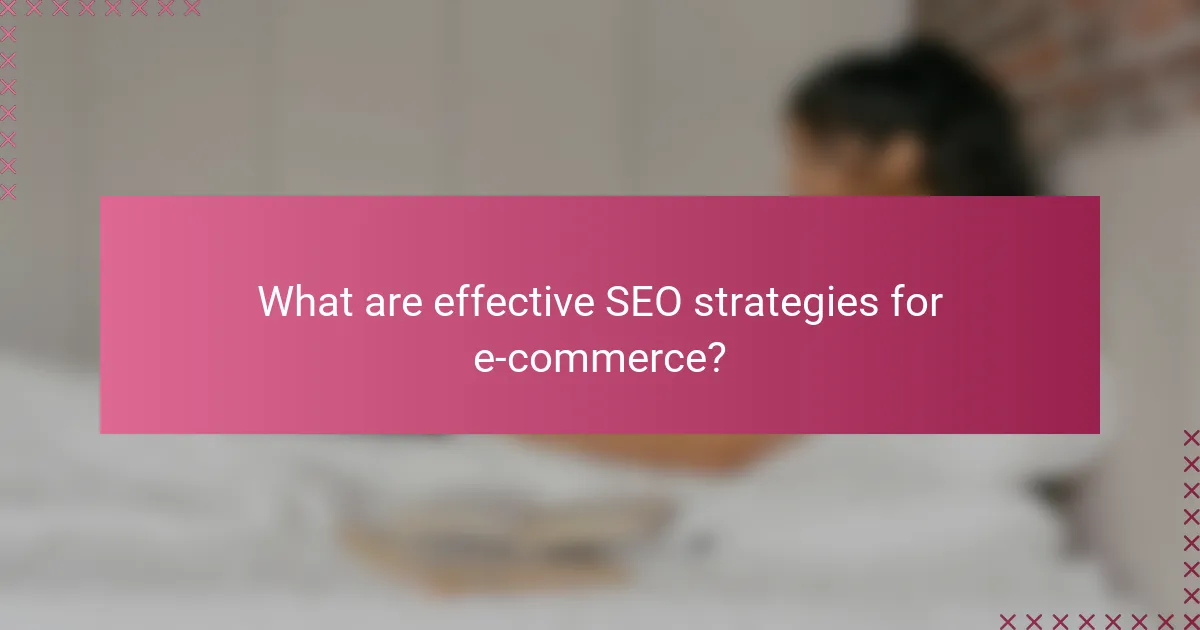In today’s competitive online landscape, effective digital marketing strategies are essential for driving traffic and increasing sales. By leveraging SEO, content marketing, social media, email campaigns, and paid advertising, businesses can enhance their visibility and engage with their target audience more effectively. Each strategy plays a crucial role in building brand loyalty and converting potential customers into loyal buyers.

What are effective SEO strategies for e-commerce?
Effective SEO strategies for e-commerce focus on optimizing your online store to improve visibility in search engine results, drive organic traffic, and ultimately increase sales. Key elements include keyword research, on-page optimization, link building, technical SEO, and local SEO practices tailored to your target audience.
Keyword research tools like Ahrefs
Keyword research is fundamental for e-commerce SEO, helping you identify the terms potential customers use to find products. Tools like Ahrefs allow you to analyze search volume, keyword difficulty, and competitor strategies. Aim for a mix of high-volume and long-tail keywords to capture various customer intents.
Utilize Ahrefs’ keyword explorer to generate a list of relevant keywords, and prioritize those with manageable competition. Regularly update your keyword strategy based on trends and seasonal changes to stay competitive.
On-page optimization techniques
On-page optimization involves enhancing individual web pages to rank higher and earn more relevant traffic. Key techniques include optimizing title tags, meta descriptions, and product descriptions with targeted keywords. Ensure that your URLs are clean and descriptive, and include keywords where appropriate.
Additionally, use high-quality images with alt text that describes the product. Implementing structured data can also help search engines understand your content better, potentially leading to rich snippets in search results.
Link building methods
Link building is crucial for improving your site’s authority and search rankings. Effective methods include guest blogging, partnerships with influencers, and creating shareable content like infographics or guides. Focus on acquiring backlinks from reputable sites within your industry.
Avoid black-hat techniques like buying links, as these can lead to penalties from search engines. Instead, build relationships with other businesses and engage in community forums to naturally earn links over time.
Technical SEO practices
Technical SEO ensures that your website meets the technical requirements of search engines for better crawling and indexing. Key practices include optimizing site speed, ensuring mobile-friendliness, and creating an XML sitemap. Regularly check for broken links and fix them to enhance user experience.
Implement HTTPS to secure your site, as security is a ranking factor. Use tools like Google Search Console to monitor your site’s health and identify any technical issues that may affect your SEO performance.
Local SEO for regional targeting
Local SEO is essential for e-commerce businesses targeting specific regions. Optimize your site for local search by including location-based keywords in your content and metadata. Create a Google My Business profile to enhance visibility in local search results.
Encourage customer reviews and engage with local directories to build your online reputation. Consider local promotions or events to attract regional customers, and ensure your contact information is consistent across all platforms to improve local search rankings.

How can content marketing boost e-commerce sales?
Content marketing can significantly enhance e-commerce sales by attracting potential customers and building brand loyalty. By providing valuable and relevant content, businesses can engage their audience, drive traffic to their online stores, and ultimately increase conversions.
Creating engaging blog content
Engaging blog content serves as a powerful tool for driving traffic and establishing authority in your niche. Focus on topics that resonate with your target audience, such as product guides, industry trends, or customer success stories. Aim for a consistent posting schedule to keep your audience engaged and returning for more.
Incorporate keywords related to your products to improve SEO and attract organic traffic. Use clear headings, bullet points, and images to enhance readability and engagement.
Utilizing video marketing
Video marketing can effectively showcase products and create a personal connection with potential customers. Consider producing product demos, tutorials, or behind-the-scenes content that highlights your brand’s personality. Videos can increase engagement rates and are often shared more than other content types.
Platforms like YouTube and social media channels are ideal for distributing video content. Keep videos concise, ideally under two minutes, to maintain viewer attention and encourage shares.
Leveraging user-generated content
User-generated content (UGC) can enhance credibility and foster community around your brand. Encourage customers to share their experiences through reviews, photos, or videos, and feature this content on your website and social media. This not only builds trust but also provides authentic content that resonates with potential buyers.
Consider running contests or campaigns that incentivize customers to create and share content. Highlighting UGC can also reduce the burden of content creation while showcasing real-life applications of your products.
Implementing content distribution strategies
Effective content distribution is crucial for maximizing the reach of your marketing efforts. Utilize social media platforms, email newsletters, and partnerships with influencers to share your content widely. Tailor your distribution strategy to each platform’s audience for better engagement.
Consider using paid promotions to boost high-performing content, ensuring it reaches a larger audience. Monitor engagement metrics to refine your strategies and focus on the channels that yield the best results.

What social media platforms are best for e-commerce?
The best social media platforms for e-commerce include Instagram, Facebook, Pinterest, and LinkedIn, each catering to different types of products and audiences. Choosing the right platform depends on your target market and the nature of your products.
Instagram for visual products
Instagram is ideal for e-commerce businesses that focus on visually appealing products, such as fashion, beauty, and home decor. The platform’s emphasis on high-quality images and videos allows brands to showcase their products effectively, attracting potential customers.
Utilize Instagram Shopping features, which enable users to purchase directly from your posts. Engaging with followers through stories, reels, and influencer partnerships can further enhance visibility and drive sales.
Facebook for targeted ads
Facebook excels in targeted advertising, making it a powerful tool for e-commerce. With its extensive user data, businesses can create highly specific ad campaigns that reach their ideal customers based on demographics, interests, and behaviors.
Consider using Facebook’s dynamic ads, which automatically show relevant products to users who have expressed interest in your brand. Regularly analyze ad performance to optimize your campaigns and maximize return on investment.
Pinterest for DIY and crafts
Pinterest is particularly effective for e-commerce brands in the DIY, crafts, and home improvement sectors. Users often turn to Pinterest for inspiration, making it a prime platform for showcasing creative projects and products.
Utilize rich pins to provide additional information about your products, such as pricing and availability. Regularly pin high-quality images and engaging content to drive traffic to your website and increase conversions.
LinkedIn for B2B marketing
LinkedIn is the go-to platform for B2B e-commerce, allowing businesses to connect with other companies and professionals. It is particularly useful for selling services or products that cater to businesses rather than individual consumers.
Focus on building a strong company profile and sharing valuable content that positions your brand as an industry leader. Engage with potential clients through targeted ads and sponsored content to generate leads and drive sales.

How to design effective email campaigns for e-commerce?
Effective email campaigns for e-commerce focus on engaging customers through targeted messaging and relevant offers. By leveraging personalization, segmentation, and automation, businesses can enhance customer experience and drive sales.
Personalization techniques
Personalization in email campaigns involves tailoring content to individual customer preferences and behaviors. This can include using the recipient’s name, recommending products based on past purchases, or sending personalized discounts. Studies show that personalized emails can significantly increase open and click-through rates.
To implement personalization, utilize customer data from your e-commerce platform. Tools like dynamic content blocks can help display relevant products or offers, making the email more appealing to each recipient.
Segmentation strategies
Segmentation involves dividing your email list into smaller groups based on specific criteria, such as demographics, purchase history, or engagement level. This allows for more targeted messaging, which can lead to higher conversion rates. For example, you might create segments for first-time buyers, repeat customers, or customers who have abandoned their carts.
Effective segmentation can be achieved by analyzing customer data and behavior. Consider using criteria like geographic location, shopping frequency, or average order value to create meaningful segments that resonate with your audience.
A/B testing for optimization
A/B testing, or split testing, is a method of comparing two versions of an email to determine which performs better. This can involve testing different subject lines, content layouts, or call-to-action buttons. A/B testing helps identify what resonates most with your audience, allowing for continuous improvement of your email campaigns.
When conducting A/B tests, ensure you test one variable at a time to accurately measure its impact. Aim for a sample size that provides statistically significant results, and analyze the data to inform future campaigns.
Automated workflows for customer engagement
Automated workflows streamline email marketing efforts by sending targeted messages based on customer actions or milestones. For instance, you can set up automated welcome emails for new subscribers, follow-up emails after a purchase, or reminders for items left in the shopping cart.
To create effective automated workflows, map out the customer journey and identify key touchpoints. Use your email marketing platform to set triggers and conditions that activate these automated messages, ensuring timely and relevant communication with your customers.

What are the benefits of paid advertising in e-commerce?
Paid advertising in e-commerce offers rapid visibility and the ability to reach specific customer segments effectively. By investing in ads, businesses can drive immediate traffic to their online stores, enhancing sales opportunities and brand awareness.
Immediate traffic generation
Paid advertising is one of the quickest ways to generate traffic to an e-commerce site. Unlike organic methods, which can take time to build momentum, paid ads can start delivering visitors almost instantly after launch. This is particularly beneficial during product launches or seasonal sales.
For example, platforms like Google Ads or Facebook Ads allow businesses to set up campaigns that can attract hundreds or thousands of visitors within hours. This immediate influx can lead to increased sales and valuable data on customer behavior.
Targeted audience reach
Paid advertising enables e-commerce businesses to target specific demographics, interests, and behaviors, ensuring that ads reach the most relevant audience. This precision increases the likelihood of conversions, as ads are shown to users who are more likely to be interested in the products offered.
For instance, using Facebook’s ad targeting options, a business can reach users based on age, location, and shopping habits. This targeted approach can improve return on investment (ROI) significantly compared to broader advertising methods.
